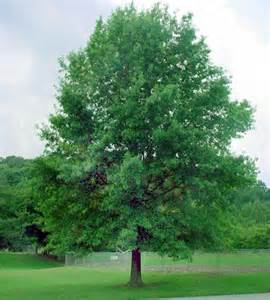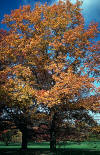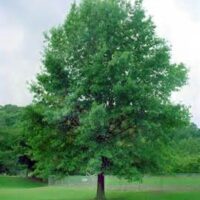Black Oak 3-4′
Scientific Name: Quercus valutina
Zone: 3-9 Click Here to Find your Zone
Mature Height: 70 ft
Mature Width: 50 ft
Growth Per Year: Slow to Medium (up to 24″)
Wet Tolerant: Yes
Drought Tolerant: Moderately
Shade Tolerant: Intermediate
Description
Black Oak also known as Yellow Oak and Yellow Barked Oak is a relatively slow growing oak, maturing with a broad round crown, leaves are 4-10 inches long, 3-8 inches wide, usually 7 to 9 lobed, lobes are bristle tipped, thick and leathery, somewhat deeply indented, shiny dark green above turning a red or brown in fall. The Black oak flowers in May, when the leaves are half grown, producing catkins 4-6 inches long. Black Oak acorns take two years to mature and are 1/2-3/4″ long, kernel is yellow and bitter. This oak tree will tolerate a wide range of soils but grows best on moist, organic, well drained acid soils and is not an important lumber tree and is hard to transplant due to taproot unless grown in root bags. The wood is heavy, hard, strong, red and is usually sold with Red Oak for flooring. The national champion Black Oak is 131′ tall in St. Clair County, Michigan. Black Oak is moderately drought tolerant, prefers sandy loam, well drained and a touch on the acid side. Black Oak can withstand polluted air, full sun and should be planted more as it is a good landscape tree. Black Oak is native to the following states: Alabama, Connecticut, District of Columbia, Delaware, Florida, Georgia, Iowa, Illinois, Indiana, Kansas, Kentucky, Louisiana, Massachusetts, Maryland, Maine, Michigan, Minnesota, Missouri, Mississippi, North Carolina, Nebraska, New Hampshire, New Jersey, New York, Ohio, Oklahoma, Pennsylvania, Rhode Island, South Carolina, Tennessee, Texas, Virginia, Vermont, Wisconsin, West Virginia. Many of the native and non-native where these trees grow have a multitude of tree nursery outlets to choose from as well as many tree farm grown selections. We also have: Burr English Oak, English Oak, Willow Oak, Chestnut Oak, Columnar English Oak, Shumard Oak, White Oak , Swamp White Oak , Northern Red Oak, Heritage Oak, Regal Prince Oak, Rocky Mountain White Oak, Pin Oak , Oregon White Oak, Burr Gambel Oak, Scarlet Oak, Sawtooth Oak, Northern Pin Oak, Bur Oak , and Chinkapin Oak. Other great evergreens in our selection include a wide variety of pine tree species. Among our most popular is the beautiful White Pine tree , available in seedling all the way to full matured trees.
Pests & Disease
Cottony maple scale is found rarely on Black Oaks. These overwinter as immature females on branches. The eggs mature in June when mock orange is in full bloom. The egg sacks look like a white fungus on the oak twigs. Not a serious pest of the Black Oak. Flat headed apple tree borer is a common pest of oaks, maples, lindens and crabapples. The female lays her eggs in wounds or cracks in the bark. The eggs hatch a few weeks after lilacs bloom. Remove any tree wrap in the spring. Larvae may be removed by hand. Gypsy moth and eastern tent caterpillars eat the leaves of most deciduous trees but seems to prefer Oak. The larvae hatch in late April and develop quickly to ravenous little monsters. A heavy infestation of gypsy moths can weaken Oak trees. An insecticide like Sevin can control the caterpillar stage of development. There are some good natural controls available now to control caterpillar populations. Spider mites can be controlled by a miticide. Two lined chestnut borer is a primary pest of Oaks. The adults lay their eggs in the cracks on the bark in late June. The larvae burrows into the wood and can’t easily be killed. The borer takes up to two years to mature and exits thru a D shaped hole similar to it’s cousin the Ash borer. Keeping the oak tree healthy will prevent allot of problems including the borer. Oak wilt is a major concern especially in the red and black oak groups. Trees can go from healthy to death in a few weeks. Wilt is caused by a fungus that can be transported by a picnic beetle or by root grafts. Although it can not be cured it can be prevented by only doing your pruning on a Black Oak in the fall or early winter. Phytophthora root rot is a soil born pathogen. This is not a common pest of the Black Oak.



